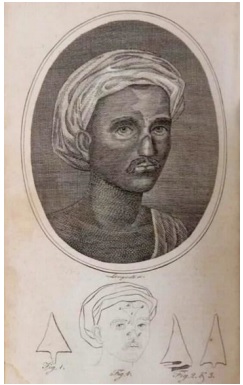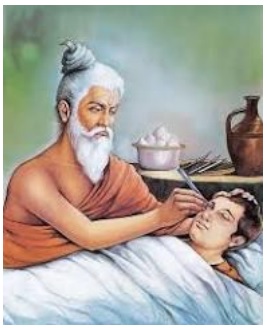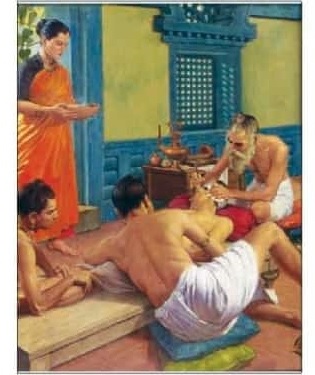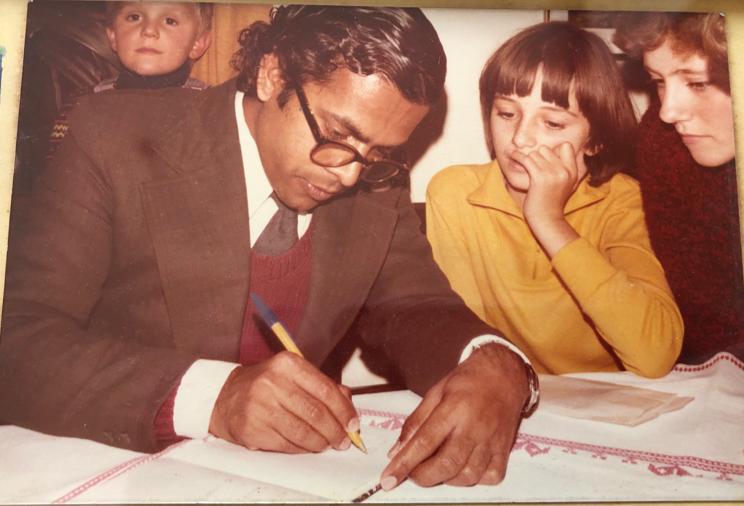ಪ್ಲಾಸ್ಟಿಕ್ ಸರ್ಜರಿಯ ಜನಕ ಸುಶ್ರುತ!
Sushruta, the father of plastic surgery!


ಬ್ರಿಟಿಷರ ಆಳ್ವಿಕೆಯ ಕಾಲದ ಅನೇಕ ಮಹತ್ವದ ದಾಖಲೆಗಳು ಲಂಡನ್ನಿನ ಬ್ರಿಟಿಷ್ ಮ್ಯೂಸಿಯಂ, ಇಂಡಿಯಾ ಆಫೀಸ್ ಲೈಬ್ರರಿ, ರಾಯಲ್ ಸೊಸೈಟಿ ಮತ್ತಿತರ ಗ್ರಂಥಾಲಯಗಳ ಪತ್ರಾಗಾರಗಳಲ್ಲಿವೆ (archives). ಅವುಗಳನ್ನು ಅನೇಕ ವರ್ಷಗಳ ಕಾಲ ಆಳವಾಗಿ ಅಧ್ಯಯನ ಮಾಡಿದವರೆಂದರೆ ಮಹಾತ್ಮಾ ಗಾಂಧೀಜಿಯವರ ನಿಕಟವರ್ತಿಗಳಾಗಿದ್ದ ಧರಂಪಾಲ್ ರವರು. ಬ್ರಿಟಿಷ್ ಮಹಿಳೆಯನ್ನೇ ಮದುವೆಯಾದ ಅವರು ಬಹಳ ವರ್ಷಗಳ ಕಾಲ ಲಂಡನ್ನಿನಲ್ಲಿ ನೆಲೆಸಿದ್ದು ಈ ಮೂಲ ದಾಖಲೆಗಳ ಆಧಾರದ ಮೇಲೆ ಅವರು ಅನೇಕ ಪುಸ್ತಕಗಳನ್ನು ಬರೆದಿದ್ದಾರೆ. ನಮಗೆ ಸುಪರಿಚಿತರಾದ ಅವರ ಮಗಳು ಡಾ. ಗೀತಾ ಧರಂಪಾಲ್ ಜರ್ಮನಿಯ ಹೈಡೆಲ್ ಬೆರ್ಗ್ ವಿಶ್ವವಿದ್ಯಾನಿಲಯದಲ್ಲಿ ಇತಿಹಾಸದ ಪ್ರೊಫೆಸರ್ ಅಗಿದ್ದು ಇತ್ತೀಚೆಗೆ ತಾನೇ ನಿವೃತ್ತರಾಗಿ ಭಾರತದಲ್ಲಿ ನೆಲೆಸಿದ್ದಾರೆ. ಇಂಗ್ಲೆಂಡ್ ಪೌರತ್ವವನ್ನು ಸುಲಭವಾಗಿ ಪಡೆಯಬಹುದಾಗಿದ್ದ ಅವರು ಅದಕ್ಕೆ ಮನಸೋಲದೆ ಭಾರತೀಯ ಪೌರತ್ವವನ್ನೇ ಆಯ್ಕೆ ಮಾಡಿಕೊಂಡು ತಂದೆಯ ದೇಶಾಭಿಮಾನವನ್ನು ಮೆರೆದಿದ್ದಾರೆ. ಕಳೆದ ಏಪ್ರಿಲ್ ತಿಂಗಳು ಅವರು ನಮ್ಮ ಮಠಕ್ಕೆ ಬಂದಾಗ ಕೊಟ್ಟ ಅವರ ತಂದೆಯ ಪುಸ್ತಕವೊಂದರಲ್ಲಿ ಕರ್ನಾಟಕಕ್ಕೆ ಸಂಬಂಧಿಸಿದಂತೆ ಕುತೂಹಲಕಾರಿಯಾದ ಒಂದು ಘಟನೆ ದಾಖಲಾಗಿದೆ.
ಮೈಸೂರು ಹುಲಿ ಎನಿಸಿದ ಟಿಪ್ಪೂ 1792ರಲ್ಲಿ ಬ್ರಿಟಿಷರ ವಿರುದ್ಧ ಶ್ರೀರಂಗಪಟ್ಟಣದಲ್ಲಿ ಯುದ್ಧ ಮಾಡಿದಾಗ ಶತ್ರು ಸೈನ್ಯದಲ್ಲಿದ್ದ ಅನೇಕ ಸಿಪಾಯಿಗಳನ್ನು ಸೆರೆ ಹಿಡಿದು ಶಿಕ್ಷಿಸುತ್ತಾನೆ. ಶತ್ರುಗಳೊಂದಿಗೆ ಸೇರಿಕೊಂಡು ಹೋರಾಟ ಮಾಡಿದ ತಪ್ಪಿಗಾಗಿ ಕಾವಾಸ್ ಜಿ ಎಂಬ ಹೆಸರಿನ ಎತ್ತಿನ ಬಂಡಿ ಚಾಲಕ ಮತ್ತಿತರ ನಾಲ್ವರು ಮರಾಠಾ ಸೈನಿಕರ ಮೂಗನ್ನು ಕತ್ತರಿಸಿ ಬ್ರಿಟಿಷ್ ಪಾಳಯಕ್ಕೆ ಕಳುಹಿಸುತ್ತಾನೆ. ಕೆಲವು ದಿನಗಳ ನಂತರ ಬ್ರಿಟಿಷ್ ಕಮಾಂಡಿಂಗ್ ಆಫೀಸರ್ ಯಾವುದೋ ಸಂದರ್ಭದಲ್ಲಿ ಮರಾಠಾ ವ್ಯಾಪಾರಿಯೊಬ್ಬನನ್ನು ಸಂಧಿಸುತ್ತಾನೆ. ಆ ವ್ಯಾಪಾರಿಯ ಮೂಗು ನೋಡಲು ಸ್ವಲ್ಪ ವಿಚಿತ್ರವಾಗಿರುವುದನ್ನೂ ಮತ್ತು ಹಣೆಯ ಮೇಲೆ ತ್ರಿಕೋನಾಕಾರದ ಗುರುತು ಇರುವುದನ್ನೂ ಗಮನಿಸುತ್ತಾನೆ. ವಿಚಾರಿಸಿದಾಗ ವ್ಯಭಿಚಾರದ ಅಪರಾಧಕ್ಕಾಗಿ ಆ ವ್ಯಾಪಾರಿಯ ಮೂಗನ್ನು ಕತ್ತರಿಸಲಾಗಿತ್ತೆಂದೂ ನಂತರ ಅವನು ಮರಾಠಾ ವೈದ್ಯರಿಂದ ಶಸ್ತ್ರಚಿಕಿತ್ಸೆ ಮಾಡಿಸಿಕೊಂಡು ಬದಲಿ ಮೂಗನ್ನು ಪಡೆದಿರುವನೆಂದೂ ತಿಳಿದು ಬರುತ್ತದೆ. ಆಗ ಬ್ರಿಟಿಷ್ ಕಮಾಂಡಿಂಗ್ ಆಫೀಸರ್ ಆ ಮರಾಠಾ ವೈದ್ಯನನ್ನು ಕರೆಸಿ ತನ್ನ ಪಾಳಯದಲ್ಲಿದ್ದ ಮೂಕೊರೆಯರಾದ ಕಾವಾಸ್ ಜಿ ಮತ್ತಿತರ ನಾಲ್ವರು ಮರಾಠಾ ಸೈನಿಕರಿಗೆ ಬದಲಿ ಮೂಗನ್ನು ಜೋಡಿಸಿ ಸರಿಪಡಿಸಲು ಹೇಳುತ್ತಾನೆ. ಮರಾಠಾ ವೈದ್ಯನು ಒಂದೂವರೆ ಗಂಟೆಯೊಳಗೆ ಅವರ ಮೂಗಿನ ಶಸ್ತ್ರಚಿಕಿತ್ಸೆಯನ್ನು ಮುಂಬೈನ ಬ್ರಿಟೀಷ್ ವೈದ್ಯರಾದ Thomas Cruse ಮತ್ತು James Findlay ಕಣ್ಣೆದುರಿಗೆ ನಡೆಸುತ್ತಾನೆ. ಪೂನಾದಲ್ಲಿ ನಡೆದ ಈ ಬದಲಿ ಮೂಗು ಅಳವಡಿಕೆ ಶಸ್ತ್ರಚಿಕಿತ್ಸೆಯ ಎಲ್ಲಾ ವಿವರಗಳೂ 1794ರ ಅಕ್ಟೋಬರ್ ತಿಂಗಳಿನಲ್ಲಿ ಲಂಡನ್ನಿನ Gentleman’s Magazine ಎಂಬ ಪತ್ರಿಕೆಯಲ್ಲಿ ಪ್ರಕಟಗೊಂಡಿವೆ.

ಇದರಿಂದ ಪ್ರಭಾವಿತನಾದ J.C Carpue ಎಂಬ ಯುವ ವೈದ್ಯ ಭಾರತದಿಂದ ಹೆಚ್ಚಿನ ಮಾಹಿತಿಯನ್ನು ಪಡೆದು “ಸುಶ್ರುತ ಸಂಹಿತಾ”, “ಚರಕ ಸಂಹಿತಾ" ಮೊದಲಾದ ಪ್ರಾಚೀನ ಭಾರತದ ವೈದ್ಯಕೀಯ ಗ್ರಂಥಗಳನ್ನು ಅಭ್ಯಸಿಸುತ್ತಾನೆ. 1814ರಲ್ಲಿ ಇದೇ ಮಾದರಿಯಲ್ಲಿ ಬದಲಿ ಮೂಗು ಅಳವಡಿಸುವ ಪ್ರಯತ್ನ ಮಾಡಿ ಯಶಸ್ವಿಯಾಗಿ ಬ್ರಿಟಿಷ್ ಪ್ಲಾಸ್ಟಿಕ್ ಸರ್ಜರಿಯ ಪಿತಾಮಹನೆಂಬ ಖ್ಯಾತಿ ಪಡೆಯುತ್ತಾನೆ.


ತಾನು ಮಾಡಿದ ಈ ವಿನೂತನ ಶಸ್ತ್ರಚಿ ಕಿತ್ಸೆಯನ್ನು ಕುರಿತು 1816ರಲ್ಲಿ ಲಂಡನ್ ನಿಂದ ಪ್ರಕಟವಾದ “An Account of Two Successful Operations for Restoring a last Nose from the Integuments of the forehead” ಎಂಬ ಲೇಖನದಲ್ಲಿ ವಿವರವಾಗಿ ಬರೆದಿರುತ್ತಾನೆ. “That the art has subsisted from the most ancient period in India… The adhesion of divided parts, however, little understood, till lately, in France or England, was one of the first spectacles presented to mankind” ಎಂದು ಪ್ರಾಚೀನ ಭಾರತದ ವೈದ್ಯಕೀಯ ಜ್ಞಾನವನ್ನು ಬಣ್ಣಿಸಿದ್ದಾನೆ. ಕ್ರಿ.ಪೂ. 5ನೇ ಶತಮಾನದ “ಸುಶ್ರುತ ಸಂಹಿತಾ” ಜರ್ಮನಿಯ ಸಂಸ್ಕೃತ ವಿದ್ವಾಂಸರಿಂದ ಭಾಷಾಂತರಗೊಂಡು ಐರೋಪ್ಯ ರಾಷ್ಟ್ರಗಳ ಉದ್ದಗಲಕ್ಕೂ ಪ್ಲಾಸ್ಟಿಕ್ ಸರ್ಜರಿಯನ್ನು ಪ್ರಸಿದ್ಧಗೊಳಿಸುತ್ತದೆ.
ಮೂಗು ದೈನಂದಿನ ಆಡು ಮಾತಿನಲ್ಲಿ ಬಹಳವಾಗಿ ಬಳಕೆಯಲ್ಲಿದೆ. “ಮೂಗು ಮುರಿಯುವುದು, ಮೂಗು ತೂರಿಸುವುದು, ಮೂಗುದಾರ ಹಾಕುವುದು, ಮೂಗಿನ ಮೇಲೆ ಬೆರಳಿಡುವುದು, ಮೂಗಿರುವ ತನಕ ನೆಗಡಿ ತಪ್ಪದು, ಸಿಟ್ಟು ಅವನ ಮೂಗಿನ ಮೇಲೆಯೇ ಇದೆ” ಇತ್ಯಾದಿ. “ಸಿಟ್ಟಿನಲ್ಲಿ ಕೊಯ್ದ ಮೂಗು ಅಂಟಿಸಿಕೊಳ್ಳಲು ಬರುವುದಿಲ್ಲ” ಎಂಬ ಗಾದೆ ಮಾತನ್ನು ಸುಶ್ರುತ ಸಂಹಿತಾ ಮೇಲೆ ವಿವರಿಸಿದಂತೆ ಹುಸಿಗೊಳಿಸಿದೆ. ಸಿಟ್ಟಿನಲ್ಲೇ ಏಕೆ ಸೌಂದರ್ಯವರ್ಧನೆಗಾಗಿ ಲಕ್ಷಗಟ್ಟಲೆ ಹಣ ತೆತ್ತು ಮೂಗನ್ನು ಪ್ಲಾಸ್ಟಿಕ್ ಸರ್ಜರಿ ಮಾಡಿಸಿಕೊಳ್ಳುವ ಸೌಂದರ್ಯ ಪ್ರಿಯರೂ ಇದ್ದಾರೆ. ಇದಕ್ಕೆ ವೈದ್ಯಕೀಯ ಪರಿಭಾಷೆಯಲ್ಲಿ Rhinoplasty ಎನ್ನುತ್ತಾರೆ. ಇದರ ಮೂಲವೇ ಸುಶ್ರುತಸಂಹಿತಾ ಗ್ರಂಥದಲ್ಲಿ ವಿವರಿಸಿರುವ “ನಾಸ-ಸಂಧನ” ಶಸ್ತ್ರಚಿಕಿತ್ಸೆ, ಮೂಗಿನ ಆಕಾರ ಚೆನ್ನಾಗಿದ್ದರೆ ಮುಖದ ಸೌಂದರ್ಯ ಹೆಚ್ಚುತ್ತದೆ ಎನ್ನುತ್ತಾರೆ. ಮೂಗಿನ ಆಕಾರಗಳು ವಿಭಿನ್ನ: ಚಪ್ಪಟೆ ಮೂಗು, ಸಣ್ಣ ಮೂಗು, ದಪ್ಪನೆಯ ಮೂಗು, ತೆಳುವಾದ ಮೂಗು, ಉದ್ದ ಮೂಗು, ನೇರ ಮೂಗು, ವಕ್ರ ಮೂಗು, ಗಿಡುಗ ಮೂಗು, ಗಿಳಿಮೂತಿ ಮೂಗು ಇತ್ಯಾದಿ. ಮೂಗಿನ ಆಕಾರವನ್ನು ನೋಡಿ ವ್ಯಕ್ತಿಯ ಸ್ವಭಾವ ಏನು ಅಂತ ಹೇಳಬಹುದು ಎನ್ನುತ್ತಾರೆ. ವಿವಿಧ ವಿನ್ಯಾಸದ ಮೂಗಿನವರ ಗುಣ ಸ್ವಭಾವಗಳು ಹೇಗಿರುತ್ತವೆಯೆಂದು ಸಾಮುದ್ರಿಕ ಶಾಸ್ತ್ರ ಹೇಳುತ್ತದೆ.

ಜರ್ಮನ್ ಭಾಷೆಯಲ್ಲಿ ಆಸ್ಟ್ರಿಯಾ ದೇಶದ ಜನರ ಮೂಗನ್ನು Himmelstoßnase ಎಂದು ಗೇಲಿ ಮಾಡುತ್ತಾರೆ. ವಿಯೆನ್ನಾ ವಿಶ್ವವಿದ್ಯಾನಿಲಯದಲ್ಲಿ ಓದುತ್ತಿದ್ದಾಗ (1977-79) ನಾವು ಗಮನಿಸಿದಂತೆ ಅದಕ್ಕೆ ಕಾರಣ ಅವರ ಮೂಗಿನ ತುದಿ ಸ್ವಲ್ಪಮಟ್ಟಿಗೆ ಆಕಾಶದ (Himmel) ಕಡೆ ಅಂದರೆ ಮೇಲಕ್ಕೆ ಚಾಚಿಕೊಂಡಿರುತ್ತದೆ. ಯೂರೋಪಿನಲ್ಲಿ ಎಲ್ಲಿಯೇ ಪ್ರವಾಸ ಮಾಡಲಿ ಅಂತಹ ಮೂಗುಳ್ಳವರನ್ನು ಕಂಡರೆ ಅವರನ್ನು ಆಸ್ಟ್ರಿಯಾ ದೇಶದವರು ಎಂದು ಸುಲಭವಾಗಿ ಗುರುತಿಸಬಹುದು. ಮೊದ ಮೊದಲು ನಮಗೆ ಯೂರೋಪಿಯನ್ನರೆಲ್ಲರೂ ಬೆಕ್ಕುಗಳಂತೆ ಒಂದೇ ರೀತಿ ಕಾಣಿಸುತ್ತಿದ್ದರು. ಎರಡು ವರ್ಷಗಳ ವಿದ್ಯಾರ್ಥಿ ಜೀವನದಲ್ಲಿ ಕ್ರಮೇಣ ಬ್ರಿಟಿಷ್, ಫ್ರೆಂಚ್, ಜರ್ಮನ್, ಡಚ್ ಮತ್ತು ಇಟಾಲಿಯನ್ನರು ಯಾರೆಂದು ಅವರ ಮುಖ ನೋಡಿ ಸುಲಭವಾಗಿ ಗುರುತಿಸುವ ಕ್ಷಮತೆ ಉಂಟಾಯಿತು. ಒಮ್ಮೆ ಇಟಲಿಯ ರೋಂ ನಗರಕ್ಕೆ ಹೋದಾಗ ನಾವು ವಾಸವಾಗಿದ್ದ ಆತಿಥೇಯರ ಮನೆಯವರೊಂದಿಗೆ ಲೋಕಾಭಿರಾಮವಾಗಿ ಮಾತನಾಡುವಾಗ ಅವರ ಮಗಳ ಮೂಗು ಆಸ್ಟ್ರಿಯಾ ದೇಶದವರ Himmelstoßnase ಇದ್ದಂತೆ ತೋರುತ್ತದೆ ಎಂದು ಹಾಸ್ಯ ಮಾಡಿದಾಗ ತಂದೆ ಆಸ್ಟ್ರಿಯಾ ಮೂಲದವರು ತಾಯಿ ಇಟಾಲಿಯನ್ ಎಂದು ಗೊತ್ತಾಗಿ ಎಲ್ಲರೂ ನಗೆಗಡಲಲ್ಲಿ ತೇಲುವಂತಾಯಿತು.
ಸಾಹಿತ್ಯ ಗ್ರಂಥಗಳಲ್ಲಿ ಮೂಗನ್ನು ಸಂಪಿಗೆ ಎಸಳಿಗೆ ಹೋಲಿಸುತ್ತಾರೆ. ಮೂಗು ಮುಖಕ್ಕೆ ಸೌಂದರ್ಯವನ್ನು ತಂದುಕೊಡುತ್ತದೆ. ಆದಕಾರಣವೇ “ಮೂಗಿಲ್ಲದ ಮುಖಕ್ಕೆ ಶೃಂಗಾರವೇ ಅಯ್ಯಾ!” ಎಂದು ಬಸವಣ್ಣನವರು ಉದ್ಗರಿಸುತ್ತಾರೆ. “ಕೊಯ್ದ ಮೂಗಿಂಗೆ ಕನ್ನಡಿಯ ತೋರುವಂತಪ್ಪ ವೇದನೆಯಹುದೆನಗೆ!” ಎಂದು ಮತ್ತೊಂದೆಡೆ ವಿಷಾದಿಸಿದ್ದಾರೆ. ಭಾರತೀಯ ಸಮಾಜದಲ್ಲಿ ಮೂಗು ಮುಖದ ಸೌಂದರ್ಯಕ್ಕೆ ಭೂಷಣವಲ್ಲದೆ ವ್ಯಕ್ತಿಯ ಘನತೆ-ಗೌರವಗಳ ಪ್ರತೀಕವೂ ಆಗಿತ್ತು. ಹಿಂದಿನ ಕಾಲದಲ್ಲಿ ಅನೈತಿಕ ಜೀವನ ನಡೆಸಿದವರಿಗೆ ಅವರ ಮೂಗನ್ನು ಕೊಯ್ದು ಶಿಕ್ಷಿಸಲಾಗುತ್ತಿತ್ತು. ಅಂಥವರು ಜೀವನದುದ್ದಕ್ಕೂ ಕಳಂಕಿತರಾಗಿ ಬದುಕಬೇಕಾಗಿತ್ತು. ಮೇಲೆ ವಿವರಿಸಿದಂತೆ ಬದಲಿ ಮೂಗು ಜೋಡಣೆಯ ಶಸ್ತ್ರಚಿಕಿತ್ಸೆಯಿಂದ ಅವರು ತಮ್ಮ ಮಾನ-ಮರ್ಯಾದೆಯನ್ನು ಮುಚ್ಚಿಕೊಳ್ಳಲು ನೆರವಾಯಿತು. ಸಾಮಾಜಿಕ ಜೀವನದಲ್ಲಿದ್ದ ಈ ಶಿಕ್ಷೆಯನ್ನು ಬಸವಣ್ಣನವರು ತಮ್ಮ ಒಂದು ವಚನದಲ್ಲಿ ಆಧ್ಯಾತ್ಮಿಕ ಜೀವನಕ್ಕೆ ವಿಸ್ತರಿಸಿ ಏಕದೇವತಾ ನಿಷ್ಠೆಯನ್ನು ಪ್ರತಿಪಾದಿಸಲು ಮತ್ತು ಬಹುದೇವತಾರಾಧನೆಯನ್ನು ಖಂಡಿಸಲು ಬಳಸಿಕೊಂಡಿದ್ದಾರೆ. ಗಂಡನೊಬ್ಬ ತನ್ನ ಹೆಂಡತಿಯು ಪರಪುರುಷನೊಂದಿಗೆ ಅಕ್ರಮ ಸಂಬಂಧ ಹೊಂದಿರುವ ಜಾರಿಣಿ ಎಂದು ತಿಳಿದುಬಂದಾಗ ಸಿಟ್ಟಿಗೇಳುತ್ತಾನೆ. ಆದರೆ ತನ್ನ ಸಿಟ್ಟನ್ನು ತೋರಿಸಿಕೊಳ್ಳದೆ ಹೆಂಡತಿಯನ್ನು ಬಹಳವಾಗಿ ಪ್ರೀತಿಸುವವನಂತೆ ನಟಿಸುತ್ತಾನೆ. ಅಪರಾಧಿ ಪ್ರಜ್ಞೆಯುಳ್ಳ ಹೆಂಡತಿಗೆ ಗಂಡ ತನ್ನ ಶೀಲವನ್ನು ಶಂಕಿಸುತ್ತಿಲ್ಲ ಎಂದು ಸಮಾಧಾನವಾಗುತ್ತದೆ. ಆದರೆ ಗಂಡ ಆಕೆಯ ಮೂಗನ್ನು ಹಿಡಿದು ವರ್ಣನೆ ಮಾಡಿ ಕ್ಷಣಾರ್ಧದಲ್ಲಿ ಕೊಯ್ದು ಹಾಕುತ್ತಾನೆ. ಹಾಗೆಯೇ ಒಬ್ಬ ದೇವರನ್ನು ನಂಬದೆ ಅನೇಕ ದೇವರುಗಳನ್ನು ಆರಾಧಿಸುವ ಡಾಂಭಿಕರಿಗೆ ಅದೇ ತೆರನಾದ ಶಿಕ್ಷೆಯನ್ನು ದೇವರೇ ಕೊಡುತ್ತಾನೆ ಎಂದು ಬಸವಣ್ಣನವರು ಈ ಮುಂದಿನ ವಚನಗಳಲ್ಲಿ ತೀವ್ರ ತರಾಟೆಗೆ ತೆಗೆದುಕೊಂಡಿದ್ದಾರೆ.
ಊಡುವ ಉಡಿಸುವ ಗಂಡನಿದ್ದಂತೆ
ದೇವನೊಬ್ಬ ನಾಮ ಹಲವು:
ಮಡಕೆ ದೈವ, ಮೊರ ದೈವ ಬೀದಿಯ ಕಲ್ಲು ದೈವ
ನಂಬಿದ ಹೆಂಡತಿಗೆ ಗಂಡನೊಬ್ಬ ಕಾಣಿರೋ!
-ಶ್ರೀ ತರಳಬಾಳು ಜಗದ್ಗುರು
ವಿಜಯ ಕರ್ನಾಟಕ
ಜೋಡೆ ಮಿಂಡಂಗೆ ಕಣ್ಣು ಚೆಲ್ಲುವಳ
ಕೇಡಿಂಗೆ ಬೆರಗಾದೆ ನಾನು!
ನಮ್ಮ ಕೂಡಲಸಂಗಮದೇವನು
ಸಿಂಗಾರದ ಮೂಗ ಬಣ್ಣಿಸಿ ಹಲುದೋರೆ ಕೊಯ್ವ
ಪರಮ ಪತಿವ್ರತೆಗೆ ಗಂಡನೊಬ್ಬ
ಮತ್ತೊಂದಕ್ಕೆರಗಿದರೆ ಕಿವಿ-ಮೂಗ ಕೊಯ್ವನು!
ಹಲವು ದೈವದ ಎಂಜಲ ತಿಂಬವರನೇನೆಂಬೆ
ಕೂಡಲ ಸಂಗಮದೇವಾ!
ಹಣಿಕೆ ದೈವ, ಬಿಲ್ಲ ನಾರಿ ದೈವ
ಕೊಳಗ ದೈವ, ಗಿಣ್ಣಿಲು ದೈವ,
ದೈವ, ದೈವವೆಂದು ಕಾಲಿಡಲಿಂಬಿಲ್ಲಾ!!
ದೇವನೊಬ್ಬನೆ ಕೂಡಲಸಂಗಮದೇವ.
ನಂಬಬಲ್ಲ ಭಕ್ತಂಗೆ ದೇವನೊಬ್ಬ ಕಾಣಿರೋ!
ಬೇಡ! ಬೇಡ! ಅನ್ಯದೈವದ ಸಂಗ
ಹಾದರ ಕಾಣಿರೋ!
ಕೂಡಲಸಂಗಮದೇವ ಕಂಡರೆ
ಮೂಗಕೊಯ್ವ ಕಾಣಿರೋ!
ಡಾ|| ಶಿವಮೂರ್ತಿ ಶಿವಾಚಾರ್ಯ ಮಹಾಸ್ವಾಮಿಗಳವರು
ಸಿರಿಗೆರೆ.
ಬಿಸಿಲು ಬೆಳದಿಂಗಳು ದಿ. 15-6-2023.



